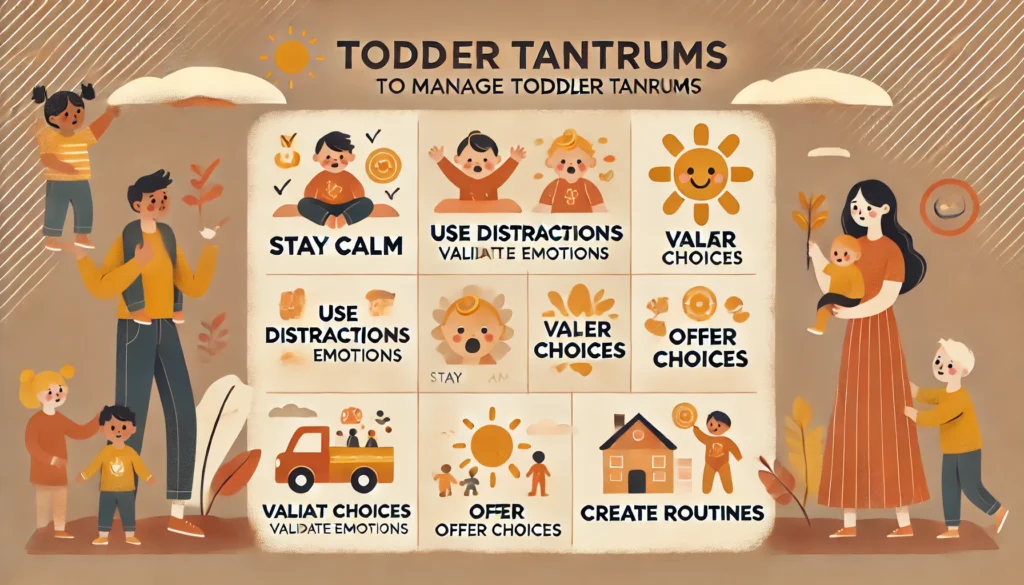
End Toddler Tantrums Now with These Genius Tricks
Tantrums are a natural part of toddlerhood. While they can be overwhelming, understanding their causes helps parents manage them effectively. Moreover, using science-backed techniques, caregivers can stay calm and guide children through emotional outbursts. Therefore, this article explores the best ways to handle toddler tantrums without stress.

Understanding Toddler Tantrums
Why Do Toddlers Have Tantrums?
Toddlers experience big emotions with limited communication skills. Consequently, frustration often leads to outbursts. Their brains are still developing, making self-regulation difficult. Furthermore, hunger, fatigue, and overstimulation can also trigger meltdowns.
The Science Behind Emotional Outbursts
Brain development plays a key role in tantrums. Since the prefrontal cortex, responsible for impulse control, is still maturing, toddlers struggle with self-regulation. Meanwhile, the amygdala, which processes emotions, is highly active. As a result, this imbalance explains why toddlers find it difficult to manage strong feelings.
Strategies for Preventing Tantrums
Creating a Predictable Routine
Consistency gives toddlers a sense of security. Similarly, clear schedules help them know what to expect, reducing frustration. In addition, simple routines for meals, naps, and playtime promote emotional stability.
Meeting Basic Needs for Tantrums
Hunger and fatigue are common tantrum triggers. Therefore, offering snacks at regular intervals prevents low blood sugar-related mood swings. Likewise, ensuring enough sleep also improves emotional regulation.
Encouraging Communication
Toddlers often cry out of frustration when they struggle to express themselves. Consequently, teaching simple words or sign language helps them communicate better. Additionally, validating their feelings also makes them feel understood.
How to Respond During a Tantrum
Staying Calm and Composed Tantrums
Children mirror adult emotions. Thus, remaining calm prevents escalation. Furthermore, deep breaths and a steady tone reassure toddlers and help them settle down faster.
Using Distraction Techniques
Shifting attention to another object or activity helps toddlers refocus. For instance, offering a favorite toy, singing a song, or pointing out something interesting can diffuse tension.
Validating Emotions Without Giving In Tantrums
Acknowledging feelings fosters emotional intelligence. Saying, “I see you’re upset,” helps children feel heard. However, staying firm on boundaries prevents reinforcing negative behavior.
Giving Limited Choices
Providing two options gives toddlers a sense of control. For example, asking, “Do you want the red or blue cup?” avoids power struggles while still maintaining structure.
Teaching Emotional Regulation
Introducing Deep Breathing
Practicing deep breathing teaches toddlers self-soothing techniques. Moreover, encouraging them to take slow breaths during calm moments prepares them for stressful situations.
Using Time-In Instead of Time-Out
Instead of isolating a child, a time-in approach offers comfort. Specifically, sitting together in a quiet space helps toddlers process emotions while feeling supported.
Modeling Emotional Control
Toddlers learn by observing. Consequently, demonstrating patience and problem-solving shows them how to manage frustration in a healthy way.

When to Seek Professional Help
Recognizing Red Flags
Frequent, intense tantrums beyond age four may indicate underlying issues. Therefore, seeking guidance from a pediatrician or child psychologist ensures proper support.
Understanding Sensory Sensitivities
Some toddlers react strongly to loud noises, bright lights, or certain textures. If tantrums seem linked to sensory overload, an occupational therapist can provide coping strategies. Furthermore, early intervention can significantly improve a child’s ability to regulate emotions.
Conclusion
Managing toddler tantrums without stress is possible with the right approach. By understanding emotional development, setting clear routines, and responding with patience, caregivers can guide children through outbursts. Moreover, consistency and empathy create a positive environment where toddlers feel safe while learning emotional regulation. Ultimately, with practice, tantrums become less frequent, making parenting a more enjoyable journey.






